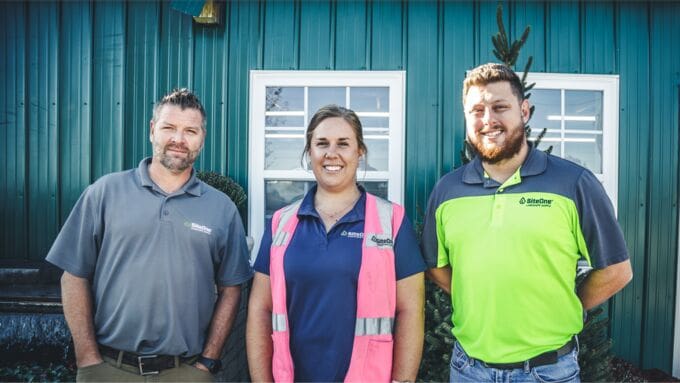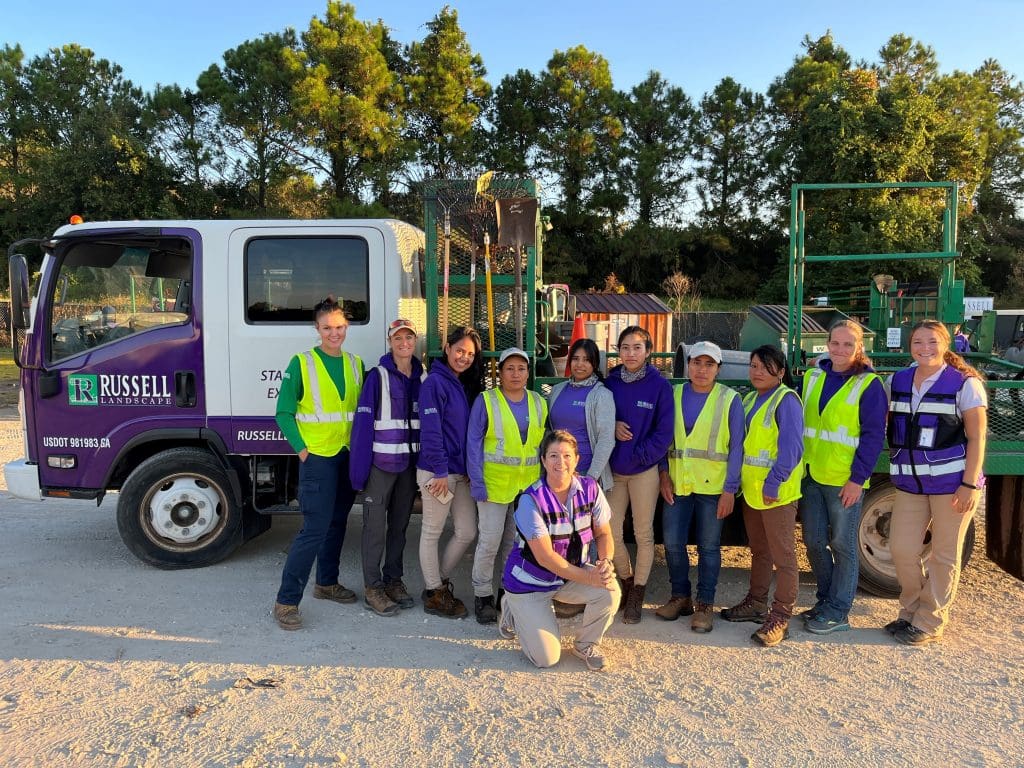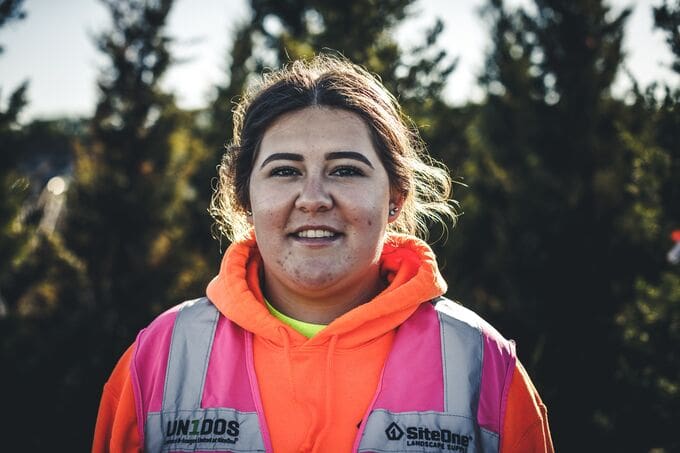
To support a successful growing company, you need the most capable people on your team, regardless of their age, race, religion, gender or national origin.
“In order to be competitive in the ever-changing landscape of business, new ideas, thoughts and ways of doing things need to be embraced and cultivated,” says Angela Hieronimus, director of engagement and success for Blades of Green, based in Edgewater, Maryland. “These come from a diversity of experiences, both in business and in life. Moreover, without a diverse workforce, think about the opportunities companies are missing out on in an already competitive labor market. Solely looking for a candidate pool that looks and acts like the majority of those employed is a complete disservice to the company and perpetuates a persona that a company is biased, and maybe even prejudiced.”
Teddy Russell, CEO of Russell Landscape Group, based in Sugar Hill, Georgia, says while it may be more comfortable for an owner to hire people who are just like them, this also limits their growth.
“The more diversity within the company allows us to recruit and retain a diverse workforce,” Russell says. “The branches and areas of our company that are more diverse are better able to recruit and retain a larger pool of great employees. They also tend to offer more creative ideas for the entire company to improve.”
Joe Ketter, EVP of human resources for SiteOne Landscape Supply, based in Roswell, Georgia, agrees that a diverse workforce provides different perspectives and better solutions. He adds that it’s also important your associates reflect your diverse customer base.

“Having a diverse workforce means happier and healthier employees, customers feel more respected, and managers have greater access to the talent and skillsets they need for their departments to thrive,” says Anterro Graham, general manager for Pro Cutters Lawnscapes, based in Conyers, Georgia. “It has made a difference to our customer base to see a diverse employment pool working together. We believe the team should reflect the general makeup of our society.”
While it’s unlikely you’ve actively discriminated against hiring diverse employees, it is important to be intentional about it. Both Hieronimus and Russell say that while they’ve always been open to new hires of all backgrounds, it’s different from actively recruiting from these talent pools.
“As we navigated the challenges of finding good talent, we became cognizant that while we had never discriminated against female technicians, we also never made a specific effort to make it welcoming to that demographic either,” Hieronimus says. “As we explored further, we quickly realized that needed to change.”
She says increasing the diversity in their front-line team members has brought to light a number of topics that had not been part of the discussion previously. Brandon Morris, executive assistant/interviewer for Pro Cutters, says they also recognized they didn’t have a lot of female participation in their workforce, so they made a concerted effort to increase their staff’s diversity in women and different minorities as well.
“We want to give everyone an opportunity to join the landscaping industry and find passions that they may not have known they had,” Morris says. “We are an equal opportunity company that also gives second chances. We know people make mistakes in their past, but that shouldn’t stop their growth in life by those mistakes.”
Cultivating a diverse workforce can be daunting if you don’t know where to start. To help with this, the NALP Foundation has identified and outlined the best ways to recruit and retain underrepresented workforce in different work areas.
Effective Recruiting Methods
One of the recruiting changes that Blades of Green made was reviewing their job ads and description language through a platform called Textio to see if they were speaking in a primarily feminine or masculine tone. Hieronimus says it has made a difference in the number of female applicants applying.
Ketter says one method that has benefited them is focusing on whether the candidate shows SiteOne’s values and DNA, rather than having a background related to the industry.

“The recipe for success is hiring these what we call A players for our A roles,” Ketter says. “A players reflect our DNA. They’re customer obsessed. They are collaborative. They are team players. They’re professional. They’re talent obsessed. All these are key ingredients to our DNA.”
SiteOne looks for these A players at tech schools and agricultural colleges and brings these individuals in as interns. From there, they can educate and build relationships with them and make offers to the most promising candidates.
Russell acknowledges that people tend to hire people who look and feel like them. Russell Landscape Group has implemented a personality profile test to avoid unintentional biases.
“This provides a report to the manager before anyone ever meets and it tells if the potential new hire has the work traits we are looking for within any particular position,” Russell says.
Ketter says they have also made a point to conduct pay equity reviews and offer benefits packages that resonate with minorities such as Hispanics, women and LGBTQ+ associates. Meanwhile, Blades of Green has reconsidered some of their positions, offering part-time and remote work opportunities to appeal to working parents.
Hieronimus says they’ve added a diversity of photos to their website and job ads that reflect their current workforce.
“The reality is individuals want to work for a company where there are people that look like them,” she says. “These simple photos showcase that we are a company that cares about diversity and it’s more than just what we say. One of our owners always talks about creating ‘overwhelming visual proof.’ Any company can have one photo reflecting their diverse workforce, but you can’t ‘fake it’ over and over again.”
Russell can attest that having a diverse team attracts more diversity, as their branch manager in Destin, Florida, is female.

“Over a short period of time, there have been more and more females who have come to work for this branch,” he says. “I believe they are excited to work for a female leader and (it) shows a path that they can also take. Today, this particular branch is over 1/3 female employees. Not only have we been able to recruit a part of the workforce where other companies have struggled, but we are also experiencing higher retention rates for these employees.”
Morris says they tried to find diverse workers online but their most successful method has been through word of mouth as people see their current personnel out working.
“They see the work we do and how we carry ourselves, which is giving us advertisement by just doing what we do,” Morris says. “We pride ourselves on our work ethic and working in excellence. Also, seeing various faces out there working shows that anyone can join us. This shows to the public our values and how we do business.”
Effective Retention Strategies
One of the main methods to ensure you retain your diverse hires is to ask questions and gather feedback. Hieronimus points out that you can implement initiatives that sound good, but you don’t know if they’re making an impact unless you talk to your employees.
Blades of Green implemented their Diversity and Inclusion Committee to serve as a safe environment for individuals to come together and discuss challenges that relate to gender identity, race and ethnicity and ensure the company is not unintentionally leaving out a group of people in their practices.
SiteOne has multiple associate resource groups (ARGs) that serve as voluntary communities of their associates. These employees meet periodically to discuss how to make SiteOne a better place to work. Ketter says they also help with their recruiting efforts at career fairs and such.
Ketter says they listen to the feedback they receive and sometimes things are brought to their attention they weren’t even aware of that they can then correct.

Russell says he asks questions and listens. He says being open-minded and valuing the opinion of everyone is an amazing way to conquer challenges.
“As a white male, I learned not to be afraid to discuss our lack of diversity and ask people for help,” Russell says. “My advice is not to try and ‘understand’ or ‘know’ what they want or how they feel. Asking for their guidance is a great way to start and it will be appreciated.”
Engagement surveys can also be conducted to identify areas that need to be addressed. Employees will be motivated when they see you acting on the received feedback to improve. Pro Cutters focuses on the five Rs: responsibility, respect, revenue-sharing, reward and relaxation time.
“We strive heavily to make sure our employees are happy and that we care about their well-being,” Morris says. “Giving them ample opportunities to gain more responsibility and experience. Showing them respect no matter the situation. As we grow financially, they know that they can grow along with us. Giving them rewards when they do exceptional tasks and in general throughout the season to let them know we care about them. And making sure they have a good work/life balance with their families. We don’t want to work them into the ground. We want them to be able to take care of their families and get time to spend with them.”
Ketter says they also take the time to invest in their top-performing diverse talent and provide the developmental resources so they can be considered for more leadership positions in the future.
While your leadership team needs to be bought in on your diversity and inclusion efforts, it needs to be part of your culture companywide. Ketter says those who aren’t quite getting it should be given coaching, otherwise you’ll never be able to retain the best talent from all walks of life.
Advice for Others
It’s important to understand increasing your company’s diversity is a never-ending process that takes time, so don’t get discouraged if the strategies we’ve provided in this article don’t produce results immediately.

“You just have to have the courage to do it,” Ketter says. “I think you have to have the patience and be willing to invest the time, energy and effort because you’ve got to make sure you’ve got the right leaders with the right mindset who are supportive of diversity and inclusion, or else it will backfire on you.”
When evaluating your own company’s diversity, make sure you are seeing diversity within all levels of the organization, not just in your entry-level positions. Employees need to see people like themselves who are growing and have career opportunities, or they will not stay long-term.
“We spend a lot of time and energy and effort finding those leaders that excel in our DNA and excel in our values and are performing really well,” Ketter says. “We are celebrating them, recognizing them, rewarding them, retaining them and promoting them.”
Morris says it has taken time for them to find the right people, but they have never given up.
“There is untapped potential that you can discover when you diversify your workforce,” Morris says. “Companies shouldn’t want to be discriminatory towards anyone because that shows they don’t offer equal opportunities to everyone. They could be missing something that incorporating diversity could solve.”
Ketter says at SiteOne, they don’t have quotas for their diversity as they feel it doesn’t provide incentives to make the appropriate decisions and behaviors. Russell agrees that you shouldn’t force diversity but look for opportunities. He suggests checking in with all your employees once a quarter to see what their goals and needs are to be successful.
For those concerned about their diversity efforts being seen as attempts at tokenism, Ketter says the key is hiring the best candidate for the job.
“Do not lower your standards,” Ketter says. “Do not waver on hiring the best person for the job just because of diversity because when you do that, no one wins. That goes over in a worse way with diverse populations. If they feel that they are just being promoted based on their race or gender and not their capability and what they’re bringing to the table as a qualified, talented individual, I’ve been told by a lot of minorities there couldn’t be anything more demotivating than that.”
Hieronimus also recommends an annual all-hands diversity and inclusion training day as your team needs to understand that diversity is important and what it looks like at work every day.
“For example, do you talk to your technicians about what they are to do if they encounter discrimination from a client in the field, how they report it and what the company is going to do about it?” Hieronimus says. “Does your team understand that diversity is not just about someone’s gender, race or ethnicity, but what gender pronoun they prefer in the workplace? Or, more importantly, does your team understand that diversity is about the freedom to be able to identify themselves in any way that they wish without the fear of being rejected or being seen as ‘less than.’ It is about complete respect.”
This article was published in the Jan/Feb issue of the magazine. To read more stories from The Edge magazine, click here to subscribe to the digital edition.

